ISSN ONLINE(2278-8875) PRINT (2320-3765)
ISSN ONLINE(2278-8875) PRINT (2320-3765)
R.K.Prasad1, D.K. Srivastava2, J.P. Saini3
|
| Related article at Pubmed, Scholar Google |
Visit for more related articles at International Journal of Advanced Research in Electrical, Electronics and Instrumentation Engineering
As several conventional shapes of microstrip antennas are presented and analyzed by many researchers which give us a clear view about the basic characteristics of MSA and leads toward designing different patch shapes to enhance the performance of MSA for different applications. In this paper a rectangular microstrip patch antenna is considered having a semi ring slot on the patch using IE3D simulation software and the results regarding antenna performance is obtained by the simulation. The simulation of the designed antenna structure shows the effectiveness of the antenna in terms of bandwidth, gain, directivity. The result analysis shows that the designed antenna structure is suitable for two different frequency bands (1.9 GHz and 2.7 GHz) with a bandwidth of 09.43% and 13.68% which makes this antenna structure suitable for two different types of applications. The directional capabilities i.e. gain and directivity of the designed antenna is also good which provides a maximum gain of 4.67dBi and maximum directivity of 5.39 dBi at 2.87GHz.
Keywords |
| Coaxial feeding technique, IE3D, MSA, Rectangular microstrip patch antenna, Semi ring shaped slot |
INTRODUCTION |
| Wireless Communication is one of the basic needs of this era. For any wireless communication antenna is the basic and essential requirement. With the advancement in the communication technology the size of the communication devices are getting reduced which leads towards the miniaturization of the antenna size as well. Various antenna structures such as parabolic reflector, horn antenna etc. provides good performance, but when the need arises for any planer antenna structure microstrip antenna is mostly preferred over any other antenna structure because of its shape, size and performance. |
| Microstrip antenna configuration consists of a dielectric substrate having ground plane on one side and patch geometry on the other [1]. It has several advantages such as low weight, low profile, planer configuration, low fabrication costs and capability to integrate MMIC. Along with these advantages this type of antenna has certain disadvantages as well such as low bandwidth, lesser gain, low efficiency which influence the capability of this antenna[1]. Various researches are being done by the researchers to overcome these disadvantages by using different patch geometry such as using E shaped patch[4], U shaped patch[7], L shaped patch[3] etc. Other methods to overcome these disadvantages includes use of different dielectric materials[9], use of substrate of different thickness, cutting various notches and slots in the patch geometry, antenna array[10] etc. for improving the performance which make this antenna suitable for different applications such as cellular phones, pagers, radar systems, and satellite communications systems. |
| In this paper the main emphasis is given to the enhancement of the bandwidth of the antenna by using a conventional rectangular microstrip antenna and cutting a semi ring shaped slot on it. The designing and simulation work is performed on IE3D simulation software. |
RESARCH MEATHODOLOGY |
| The research methodology includes the design of a conventional rectangular microstrip antenna and further cutting a semi ring shaped slot in the patch geometry. Further coaxial probe feeding method is used to feed the antenna. To get optimized results in terms of bandwidth, gain, directivity etc we are varying the feed locations and varying the size of the rectangular patch as well as the size of semi ring slot. These shapes and sizes of the antenna are simulated and compared to get the best result. The designing and simulation of the antenna structure is done using IE3D. |
ANTENNA DESIGN |
| The antenna is designed using a substrate having a dielectric constant of 4.2, loss tangent of 0.0013 and substrate thickness of 1.6mm. The antenna geometry is shown in fig. 1 and the dimensions of the designed antenna are shown in Table 1. |
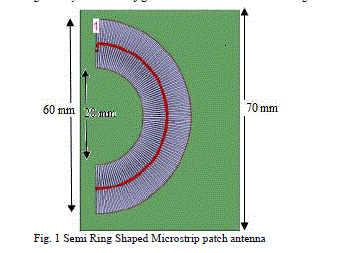 |
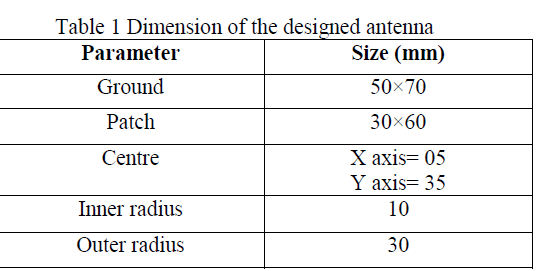 |
RESULT AND DISCUSSION |
| The designed semi ring slot rectangular Microstrip patch antenna is simulated over IE3D simulation software ver. 15.2. One of the important parameter which describes the performance of the antenna is the antenna bandwidth. The bandwidth of the antenna is calculated with the help of S-parameter. |
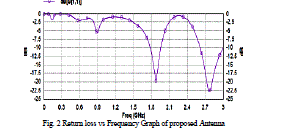 |
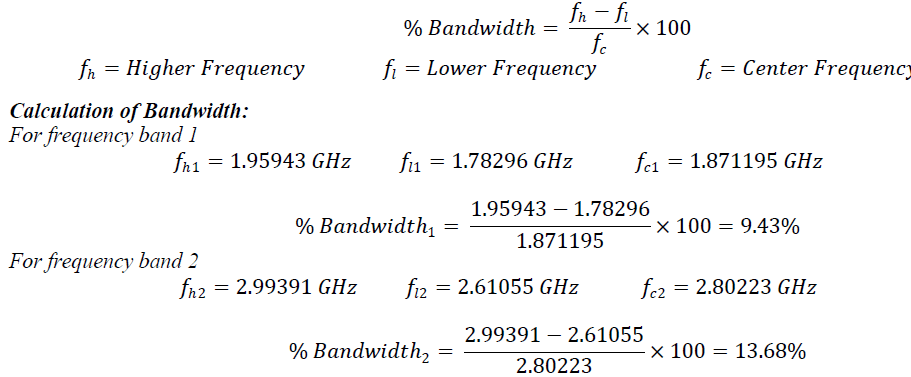 |
| The VSWR must be below two for the defined band and it can be observed from Fig. 3 that it is below two. The VSWR graph is shown below. |
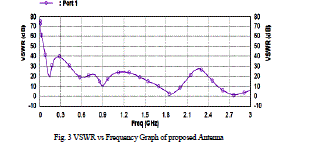 |
| Analyzing the Total Field Gain Vs Frequency curve shown in Fig. 4 we can clearly say that the antenna gain is nearly 4.67 dBi, which is very useful for various applications including wireless application. |
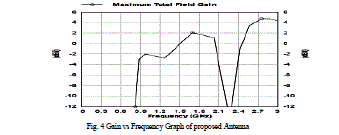 |
| Analyzing the directivity curve shown in Fig. 5 it can be observed that the designed antenna structure provides a good directivity of 5.39 dBi. |
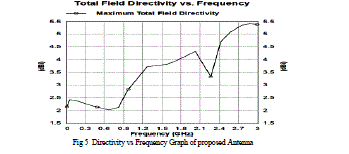 |
| Generally the efficiency is calculated in terms of antenna efficiency and radiation efficiency. Analyzing the efficiency curve shown in Fig. 6 it can be clearly observed that the designed antenna structure provides an antenna efficiency of 86.21% and radiation efficiency of 87.24% |
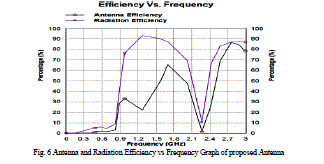 |
CONCLUSION |
| A semi ring slot rectangular microstrip patch antenna is designed and simulated over IE3D simulation software Ver. 15.2. The substrate used for the designing purpose has a dielectric constant 4.2, loss tangent 0.0013and the substrate thickness of 1.6mm. Analyzing the simulation results we come to a conclusion that the designed antenna structure can work in two different frequency bands with a bandwidth of 9.43% and 13.68%, gain of 4.67 dBi and directivity of 5.39dBi at 2.87 GHz frequency. |
References |
|